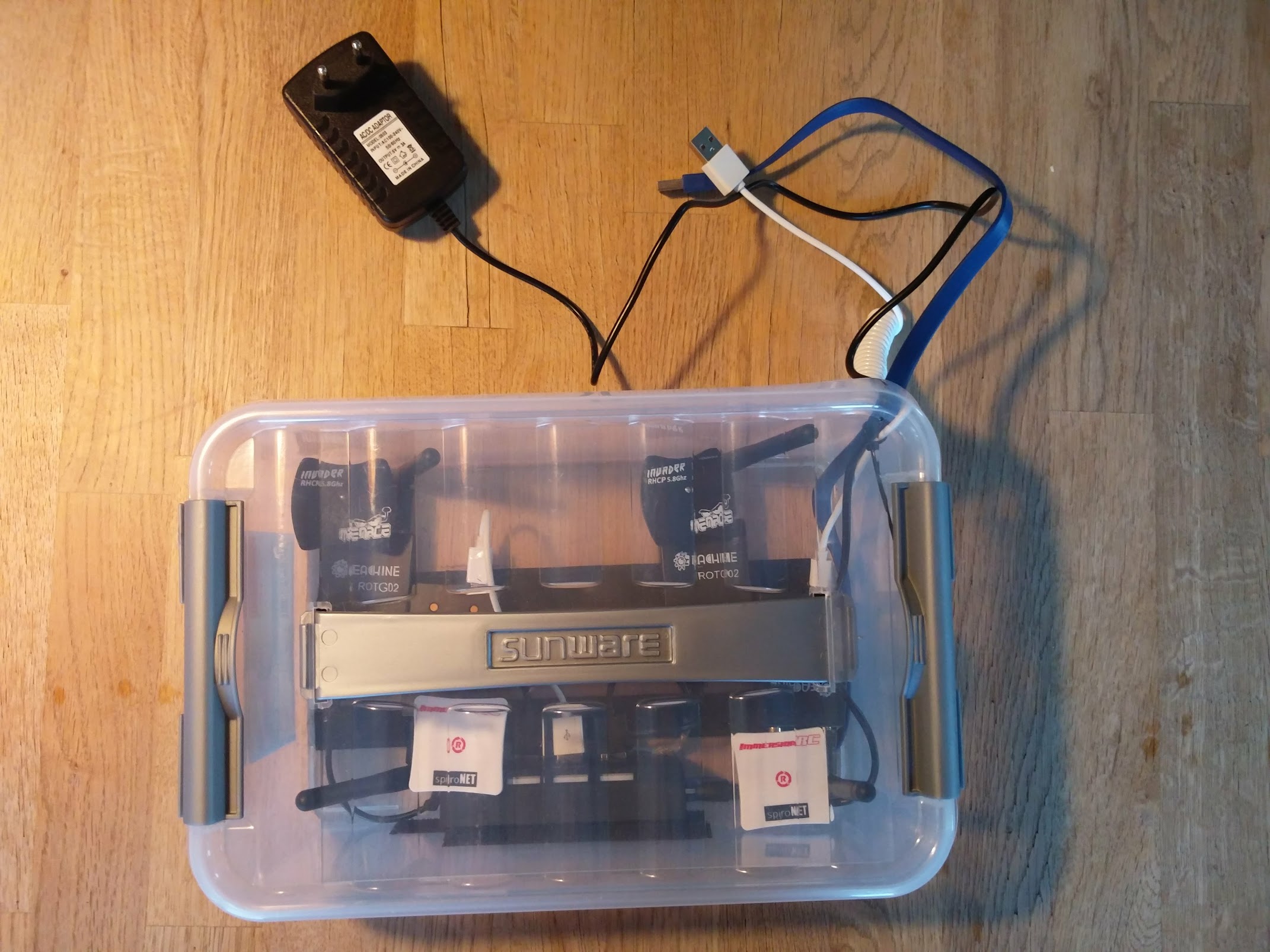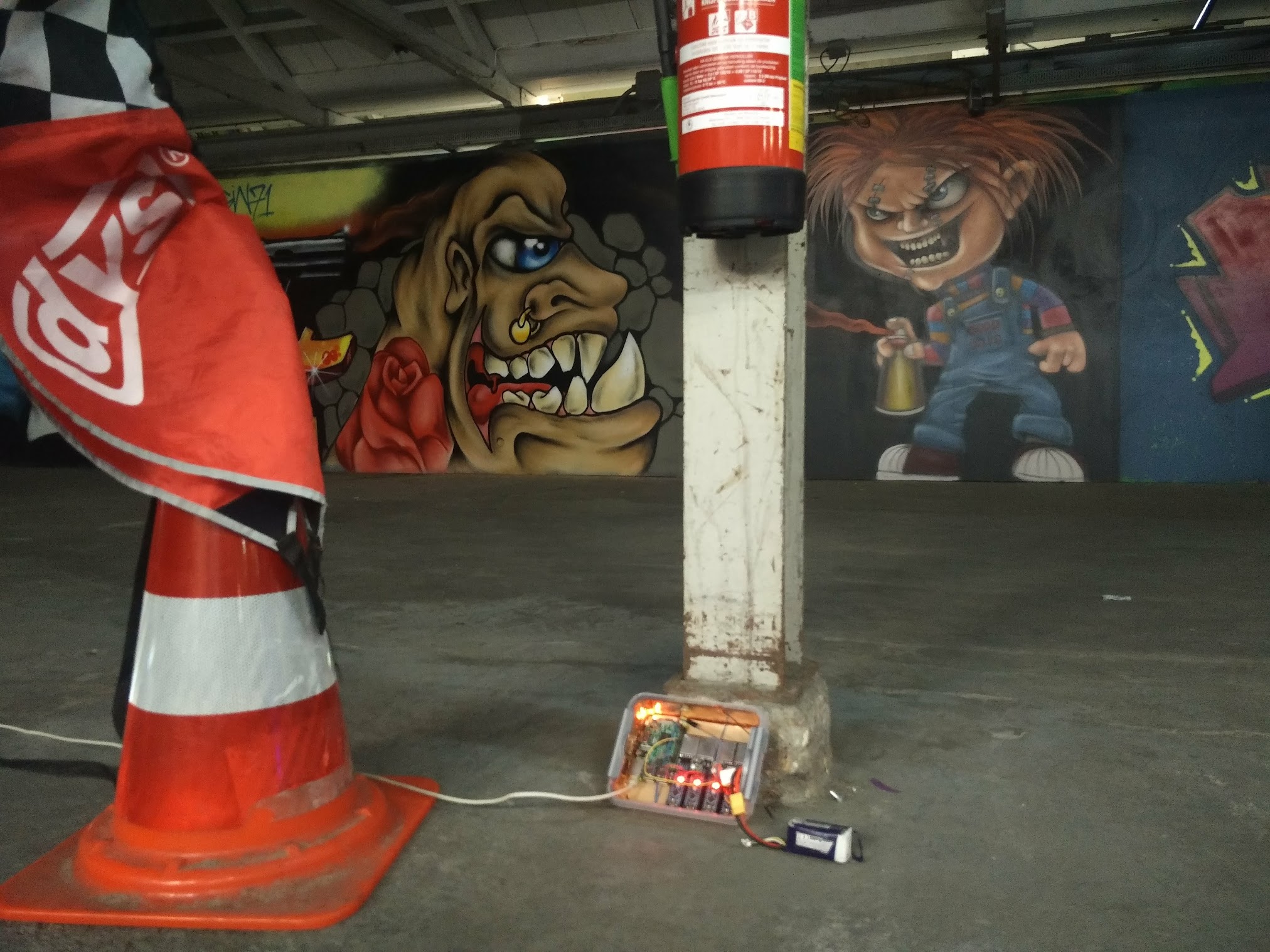On this page I showcase a reliable and cheap DIY FPV split screen for quadcopter / drone racing events. It costs about 120$ for four pilots, and 200$ for eight. It uses a couple of ROTG02 receivers and the only cables needed are USB and power. This alleviates the need of a separate DVR and capture card. My setup looks like this:

Wait wut? This thing provides a reliable split screen solution? Yes, it does! Continue reading to find out …
Table of Contents
Introduction
Whether organizing a race, or just practicing with friends, it’s great to record and/or stream DVR footage with lap times. When using a lap timer (such as LapRF 8-way or Delta 5) in combination with the LiveTime scoring engine and OBS it is possible to do so. Unfortunately, up til now, you had to rely on old bulky surveillance technology to record and stream multiple analog FPV feeds at once. Typically the Night Owl or KKMoon were used for that, but they are hard to find and suffer from problems such as black outs on low VTX signal, no possibility to input NTSC and PAL signals at the same time, and often require an extra capture card to get the DVR feed in your computer.
The below video shows the problems when pilots are using NTSC and PAL at the same time. The top left video is from an NTSC camera, the others are PAL. Note, that apart from the YouTube compression, the DVR also compressed the video and made the video look ugly as hell.
I have, however, successfully tested a different type of setup which is cheaper, more compact, and easier to build and set up in the field. It is so easy to use and install that I was even able to stream two events on one night!
The DIY DVR system
What you will need
- Some Eachine ROTG02 diversity FPV receivers
- Some antennas, e.g. Immersion RC patch antenna’s and cloverleafs
- a powered USB hub (the ROTG02 receivers draw 300mA/5V, so make sure your hub can handle the load)
- an ‘active’ USB extension cable (when you need to bridge more than 5m / 16 feet)
- some velcro tape
- a (plastic) container
- a computer (running OSX or Linux) and two or three USB 2 inputs (USB 3 is fine too).
Connecting it all together
Connecting it all up is dead easy. Just find an enclosure that will fit everything, make sure to space the antenna’s 2.5 wave lengths apart (see below), plug in the USB cables, and power it up! Here is another picture showing how it all connects:

Note that I have three ROTG02 on the powered USB hub and that I run the fourth ROTG02 separately via the white cable. (See below for why that is.)
The USB cables are then plugged into the computer running LiveTime and OBS. The pinned post on the LiveTime FPV Facebook group has instructions on how to set up OBS for displaying lap times.
I have thus reliably recorded and streamed four FPV feeds at the same time using a mid-2014 Macbook pro, running OBS and LiveTime (in Parallels).
Of course, you’ll also need a lap timer such as the Immersion RC LapRF 8-way Event Race Timing System or the open source Delta 5 Race Timer. I have successfully used both.
Advantages
- affordable (only 120$ for four pilots)
- no need for an external DVR with it’s own compression
- no need for an external capture card with it’s own compression
- no separate receivers and cabling necessary
- can handle PAL and NTSC at the same time
- diversity
- a compact setup
- easily made waterproof
- can be powered by a lipo when using a 5V 2.5A polulu
- individual streams to the computer for easy layout in OBS
(Possible) disadvantages
- no possibility to plug in normal, or better, ground stations
- RP-SMA antenna’s (although you can buy RP-SMA to SMA connectors, or just solder SMA connectors onto the ROTG02)
- Due to USB driver restrictions, this setup has been reported not to work on Windows.
Things to pay attention to
- The ROTG02 receivers are USB 2. According to OBS support, this means that the USB hub will automatically switch to USB 2 protocol (even when using a USB 3 hub). The downside is that due to USB bandwidth issues, you can thus use a maximum of three receivers on the same USB-hub / port.
- Make sure to space the antenna’s about 2.5 wave lengths apart. As our VTXs are on 5.8Ghz, the wave length is 5.1688 cm (2.035 inches). The antennas should thus ideally be spaced 12.922 cm (5.087 inches) apart (measured from the center of the antenna). HT Sander Sassen
- Make sure the power and USB cables do not block the antennas.
- You could just replace the 5V adapter by an XT60 and a 5V 2.5A polulu.
Video examples
The examples below show the DIY DVR system in action.
Here is an example of the system being used during an outdoor race in Aruba:
Note that that the next examples were all recorded in harsh environments with a lot of steel and concrete, leading to multipathing problems. In more friendly environments, there will of course be less noise. The good thing, of course, is that even with a lot of noise the image does not black out!
Three out of four pilots flying
Here is an example of three pilots flying, while the pilot at the top left did not power on his VTX. Note that due to a wrong LiveTime setting, the first lap was not counted.
NTSC (left) PAL (right)
A single pilot view in a different environment
When recording this video, the ROTG02 receiver had cloverleaf and rubber duck antennas. A patch antenna would have lessened the noise here.
3 cams without signal
Closing thoughts
A big advantage of the current setup is that we don’t need a bulky external multi-channel DVR anymore, which is outdated technology anyway and provides (crappy) compression when streamed over a network via RTSP. With the introduction of the RapidFire and ClearView goggle modules, we will soon all expect better DVR footage. Recently Immersion RC indicated that they are working on a ground-station version of the RapidFire: Duo5800 V5. If it would include USB 3 ports, I am sure that all race directors and possibly local FPV clubs would be more than happy to get rid of their Night Owls and get a reliable FPV feed straight into their computer …
FAQ
What’s up with the Total Drone Xperience logo?
Total Drone Xperience organizes drone racing events in the Netherlands. Take a look at their latest insane event: Middenwaard 2.0, where I was the race director. TDX is always great to work with! I am also a frequent visitor of their current permanent training location, The Post Office.
I still want to do it the old way. How do I do that?
Philipp Seidl has written a great post on how to set up such a system. A recent post on the LiveTime FPV Facebook group has great pointers too.
What’s the thing in the first picture?
It’s my delta 5 lap timer. Delta 5 is an awesome open source hardware project that you can assemble for about 150€ for a 4-node setup and about 200€ for an 8-node setup. Apart from accurately tracking quadcopters flying by based on their VTX RSSI signal, it also allows you to control LEDs! See the Delta 5 Github page or the Delta 5 Facebook group for more information.
How do you use the LiveTime overlay for only one or two pilots?
Rodney Wijnaar, who spearheads Total Drone Experience, and I have been trying to find the best shots. During practice, when only one or two pilots are in the air – or even when somebody crashes in a race, we like to ‘zoom in’ on just those pilots that are actually flying.
In OBS I have created 15 scenes for displaying any combination of one to four pilots. I used ‘transform’ on one or more LiveTime overlays to show the lap times corresponding with the pilot. I am currently experimenting with automatically switching scenes so that only active pilots are shown. I do so by sending WebSocket commands from my Delta5 timer to OBS, based on the current RSSI values. Drop me a line if you are interested in this system.
How did you change the colours of the LiveTime overlay?
CSS #ftw
Can I use this on Windows / Linux / Apple?
I have only tested this system on a Macbook pro (Apple/OSX). Somebody on the LiveTime FPV Facebook group pointed out that more than two ROTG02 receivers will not work in Windows, due to USB driver restrictions. Linux should be fine.
Do you need an internet connection for this?
Yes. You need internet if you want to run the LiveTime OBS overlay with lap times. Using my mobile phone as a 4G router also allows me to livestream the races. LiveTime will cut the videos automatically at the start and end of a race, and add them to the results of the corresponding race on livefpv.com
Is it possible to record each FPV channel individually?
In the LiveTime FPV group somebody managed to do so by using the (pricey) SecuritySpy software (mac only). It records each feed to its own sub directory, and has a video browser for easy browsing through heats/channels.
It would be great to find an open-source cross-platform alternative. Suggestions? Let me know!
Post last updated on 22 May 2018.
